Signmaker Profile: Sarah Toupin
by all | 28 July 2013 8:30 am
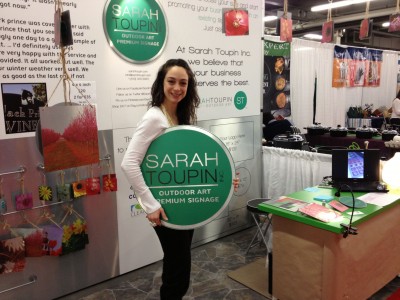 [1]By Peter Saunders
[1]By Peter Saunders
Last year, when Sarah Toupin decided to go into business for herself in Kingston, Ont., she wanted to find a niche opportunity that would let her use her existing skill set. Trained in administrative finance and interior design, with an avid interest in photography as a hobby, she concluded she could combine these talents to propose and design signage for the local business community.
“There’s always a need for advertising and signage in the business-to-business (B2B) market segment,” she says.
Creative background
Toupin was born in Montreal and moved with her family to Sherbrooke, Que., when she was still a baby. After completing high school there, she took a three-year business administration course at the mostly anglophone Champlain College in Lennoxville, Que., mainly because she could learn English and become bilingual.
Shortly after graduating, she got a position with Future Shop that took her back to Montreal. She lived there for six years, eventually quitting her job to concentrate on studying interior design, which she was inspired to try after enjoying painting classes.
“I’m more creative than suited for finance or business administration,” she explains. “I loved the beauty, quality and colour co-ordination of interior design. It was an intense course, but by the end, I could design a space from scratch, from architectural drawings to textures, lighting and furniture.”
During an internship with Look Image, an interior design firm in Montreal, she did work for a wide variety of projects, including private residences and commercial retail spaces.
A few months later, she met her common-law partner, Jason. He was in town on a business trip from Edmonton, so as their relationship grew, she joined him out west.
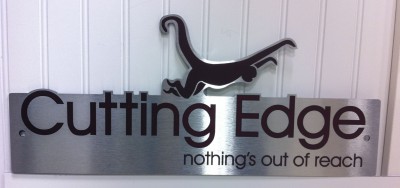 [2]
[2]Toupin’s primary material of choice is aluminum composite sheeting, which offers flexibility in fabrication and will stand up well to the elements.
“We lived together in Edmonton for three years,” she explains. “During that time, I worked for a company that sold hardwood flooring, which tied in with interior design, but I wasn’t great at being a salesperson.”
In 2010, Toupin’s partner took a job in Kingston. They have lived there since.
“When we moved, I was pregnant,” she says. “I was kept busy with our baby for the first 16 months. Then I saw an ad for a fast-track learning program that helps people start their own business, which I’ve always wanted to do.”
Becoming an entrepreneur
Toupin signed up for the course. As part of the curriculum, she had to brainstorm a variety of business concepts. Her research for this purpose eventually led her to signage.
“We had to come up with our own ideas, research them and then pitch them in the classroom,” she explains. “You had to think about who would buy your product. One of my ideas involved putting paintings and photos into frames that were backlit with light-emitting diodes (LEDs) for outdoor use, but as I researched the concept further, it wasn’t clear I would find enough customers.”
When she stumbled upon aluminum composite-based signs, however, she felt there was a greater opportunity to serve a broader market, including both businesses and private homeowners. This was key, as her course required her to forecast at least one year’s worth of work in her business plan.
 [3]
[3]In late 2012, Toupin landed her first business-commissioned signage project. Black Prince Winery in Picton, Ont., hired her to update its image on outdoor signage.
“I ordered some samples of composites and tested them out, to see exactly how they would look when turned into outdoor signs, both in colour and in black and white,” she says. “When I brought the idea to class and pitched it, we discussed it and came up with the outdoor signage market. Everyone said it would be a very good fit for me.”
Toupin finalized her business plan in July 2012 and incorporated under her own name the following month.
Material matters
One of the reasons Toupin leaned toward using the composite materials—with two prepainted aluminum sheets bonded to a solid polyethylene (PE) core—was their durability for outdoor installations. Kingston is prone to relatively severe weather conditions, especially lake-effect wind and snow, given its proximity to Lake Ontario.
“I loved the material’s low weight and sturdiness,” she says. “It could withstand the fluctuations in weather, with wind and snow bouncing off the signs. The ink adhesion is great. And it offers several fabrication options, including straight cutting, rounding and forming into three-dimensional (3-D) shapes. It can be bent, shaped and cut with curves.”
Going it alone as an entrepreneur, however, Toupin’s plan was to focus her time on running her business and designing pieces for her clients, rather than running an entire sign shop. In addition to the graphic design process itself, her tasks include travelling to meetings, ordering supplies, calculating quotes for clients, invoicing and shipping.
So, she looked into outsourcing the physical signmaking work.
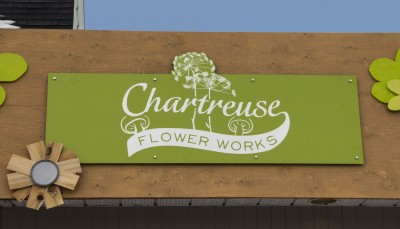 [4]
[4]This outdoor sign for a new flower shop in Kingston was produced on 3A Composites’ Dibond material with a brushed-silver finish.
“As I studied everything about how to make these products, I got in touch with a sign company in Toronto that outsources its cutting and found out who they were using,” she explains. “Now I use them to both print and cut my graphics. Next, I’m looking into laser etching and resins.”
She is also looking into substrates that allow graphics to be printed at higher resolution, as well as texture-finished composites that can be printed on both sides.
“There are lots of products in the sign industry I haven’t seen yet,” she says. “I’m not finished learning. I love to find out about all of the new technologies that are making the process of signmaking easier and better.”
Building a customer base
Following up on the market research she had done for her course, Toupin has focused her efforts primarily on targeting business customers, including wineries, golf courses, restaurants and pubs, which has involved networking through Greater Kingston Chamber of Commerce events, though she is not yet a member, and Kingston Connections, a business referral and networking group.
“Compared to my job in Edmonton, what I do now is certainly sales-oriented, but I get to be more of a product person,” she explains. “I’m a go-getter and I love to call people up, but I’m not a salesperson per se. I believe in good customer service and quality products, which will lead to referrals and more business!”
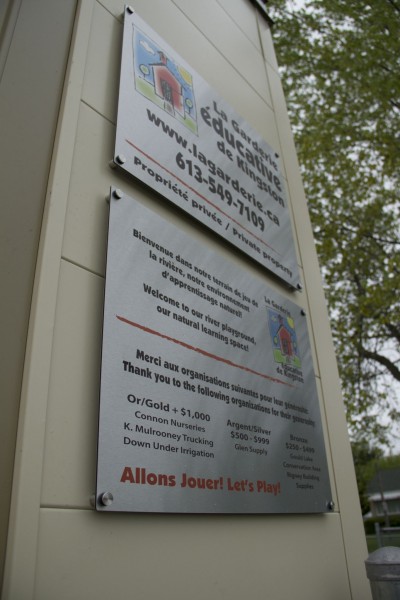 [5]
[5]Toupin does not solely work with aluminum composites. When working with La Garderie Éducative de Kingston, for example, she reproduced a logo in a scalable, vector-based format not only for outdoor signage, but also for an indoor reverse-peel window decal.
She landed her first B2B commission in September 2012, when Black Prince Winery in Picton, Ont., hired her to update its image—including that of its namesake, the black-armoured Edward of Woodstock, the eldest son of England’s King Edward III—on outdoor monument signage.
“When Sarah came across our sign, the prince was fading, peeling and pockmarked,” says Geoff Webb, principal and general manager (GM) of the winery. “The sign had been through 10 winters and taken a beating. It looked dreadful.”
Toupin used design software to manipulate a high-resolution Portable Document Format (PDF) file of the prince’s image. Then, using a digital flatbed ultraviolet-curing (UV-curing) printer, she had it printed onto a 3-mm (118-mil) thick brushed-silver sheet of aluminum composite material, which was cut with a computer numerical control (CNC) router to produce the final 457 x 610-mm (18 x 24-in.) sign.
While Toupin offers installation services, using stainless steel standoffs, the winery’s personnel chose to install the new sign themselves, directly over the fading one.
“The prince went from ugly one day to a shining example of his former self the next,” says Webb. “And the new sign withstood the winter weather very well. It all worked out. We expect this sign to be as good as the last one, if not better.”
Diversifying output
Meanwhile, Toupin also began making customized signs for individual clients’ personal use.
“Some were based on photos, with text underneath,” she says, echoing her original business idea somewhat.
In December, she pursued the consumer market for seasonal home décor with a series of circular Christmas ornaments, in 76-mm (3-in.), 127-mm (5-in.) and 178-mm (7-in.) diameters, for hanging on trees and doors. To create these pieces, she had English and French greetings printed onto the same brushed-silver sheeting used for the winery sign.
“I started selling the ornaments for the season, but soon realized they weren’t just for Christmas,” Toupin says. As a result, she began developing a year-round line of ornaments, which she sells online through Etsy.
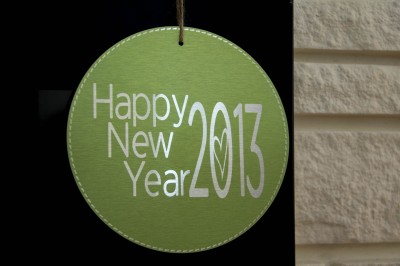 [6]
[6]After a successful launch of ornaments with Christmas and New Year’s greetings printed on brushed-silver sheeting, Toupin is now planning a year-round line.
Earlier this year, Toupin introduced another consumer product line using the same material. She exhibited a series of colourful garden stakes at the National Home Show & Canada Blooms in Toronto’s Direct Energy Centre. Although the event was primarily consumer-oriented, it was also a chance to meet prospective B2B clients and fellow exhibitors.
“My booth was divided into two sides, one for private clients and the other commercial,” she explains. “I had about 100 people interested in signs for their businesses, including landscapers and architects. I also met Paul Lafrance, who hosts Decked Out on Home & Garden Television (HGTV), and now we’re working together on a new outdoor project.”
A bigger business
Toupin runs her business from home, which has allowed her to balance her work hours with her family life, but she is looking to expand beyond what she can handle alone. She recently brought on a St. Lawrence College student as a short-term intern and says it was a win-win experience.
“I love what I do because I’m always doing something different, but I have so many potential clients and no time left to pursue them, so I need to hire a salesperson,” she says. “As the business gets bigger, I would also like to hire an accountant. The three main areas of this business are the product, the marketing and the financial side. While I can handle all three, the first one is my real strength, where I have my own style and can do something special and unique.”
Indeed, Toupin says she is driven by the potentially endless creative options for using the materials and equipment of the sign industry to reach new markets.
“I chose to incorporate under my own name rather than limit my company to signs, because I want the freedom to choose interesting projects whether they are for businesses or consumers,” she explains. “I love the freedom of self-employment. I am in charge of challenging myself with different projects.”
- [Image]: http://www.signmedia.ca/wp-content/uploads/2014/01/IMG_3282-sarah-logo-booth-2013.jpg
- [Image]: http://www.signmedia.ca/wp-content/uploads/2014/01/IMG_3586.jpg
- [Image]: http://www.signmedia.ca/wp-content/uploads/2014/01/Wineryside.jpg
- [Image]: http://www.signmedia.ca/wp-content/uploads/2014/01/IMG_3182Chartreusefullrezjpeg.jpg
- [Image]: http://www.signmedia.ca/wp-content/uploads/2014/01/IMG_33851.jpg
- [Image]: http://www.signmedia.ca/wp-content/uploads/2014/01/happynewyear2013.jpg
Source URL: https://www.signmedia.ca/signmaker-profile-sarah-toupin/